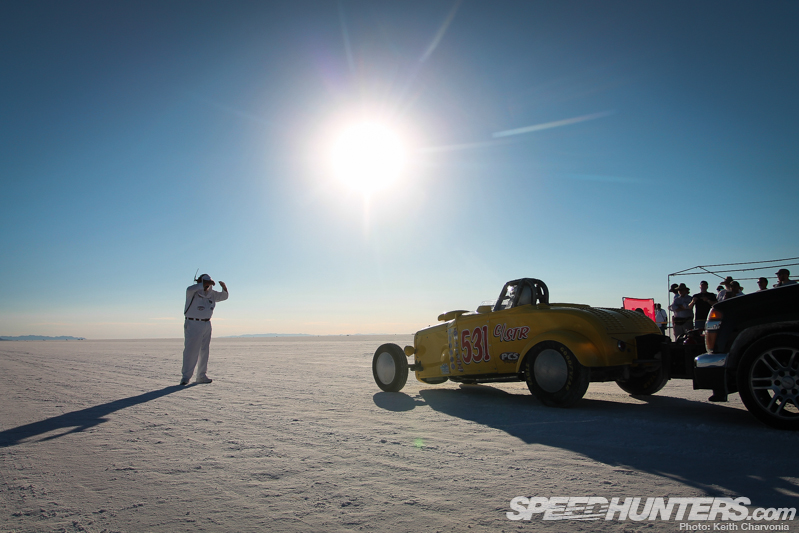
Bonneville is a mighty big place – the salt flats currently cover 30,000 acres of nothing but wide open, flat space. No plant life, no insects, not even a blade of grass sticking out of the dirt somewhere. So when Rod asked me to do a Temple of Speed story on the Bonneville salt flats it made me stop and scratch my head. I mean, how do you describe a space that’s nothing more than one giant blanket of blinding white earth?
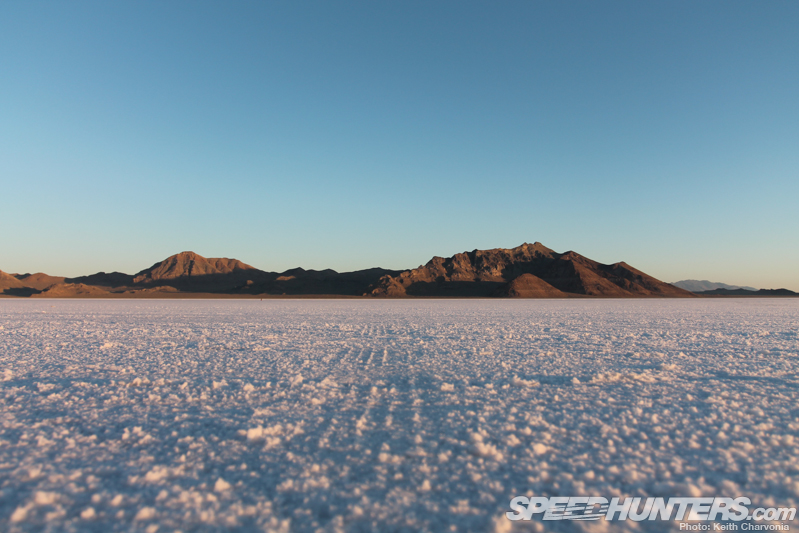
Did you notice I said the salt flats are currently 30,000 acres? They used to be three times as large, but have been shrinking due to unchecked mining operations. Wikipedia says that up to 18″ of salt has been removed since 1963 when mining began. Thankfully this has recently been remedied, and the mining companies are now pumping the salt they used to throw away back onto the flats.
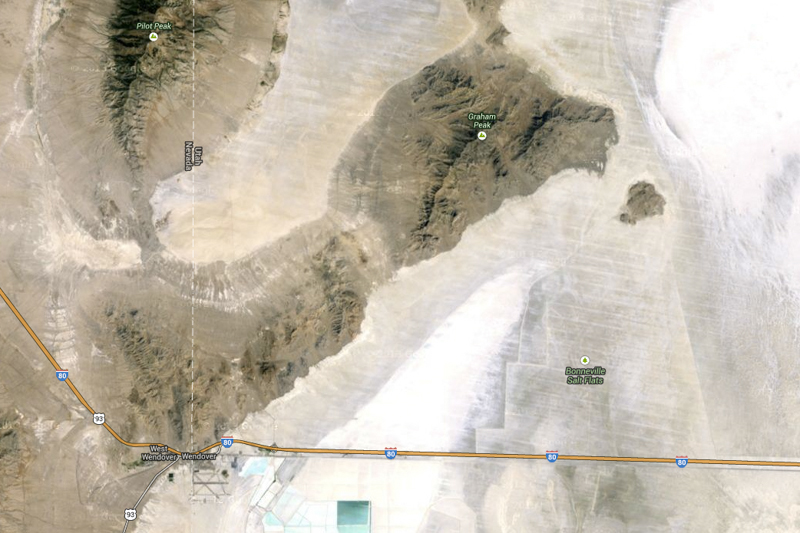
Since there aren’t any permanent structures at Bonneville and the area is so vast, Larry and I had our work cut out for us to describe Bonneville through pictures and words. Looking at this map the salty part is obvious, but we’ll start our journey in the nearest civilized place – the small gambling town of Wendover, situated directly on the border of Utah and Nevada. Photo courtesy of Google Maps
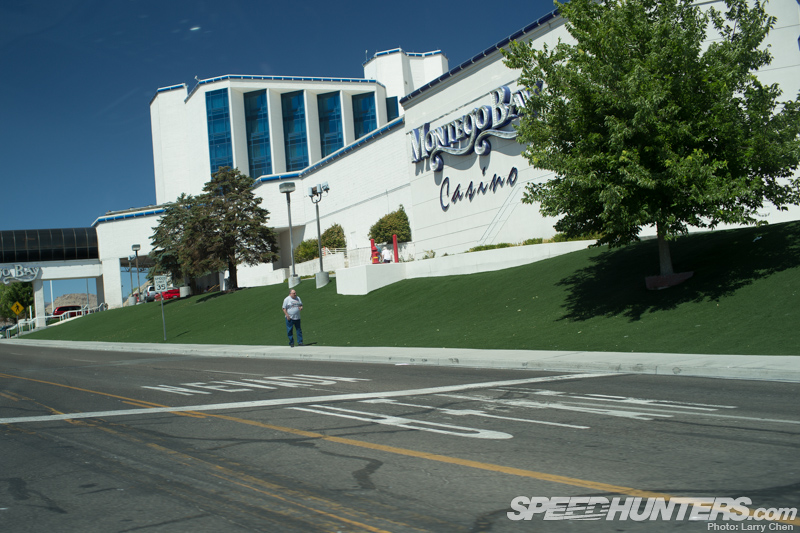
In fact the state line cuts right through the street where the hotels and casinos are located.
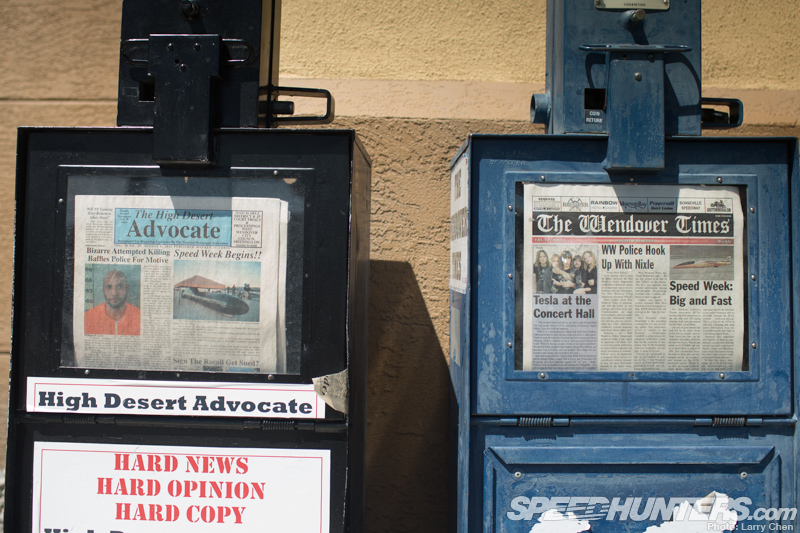
There are several racing events that take place throughout the year, but Speed Week in August is the largest and most well known.
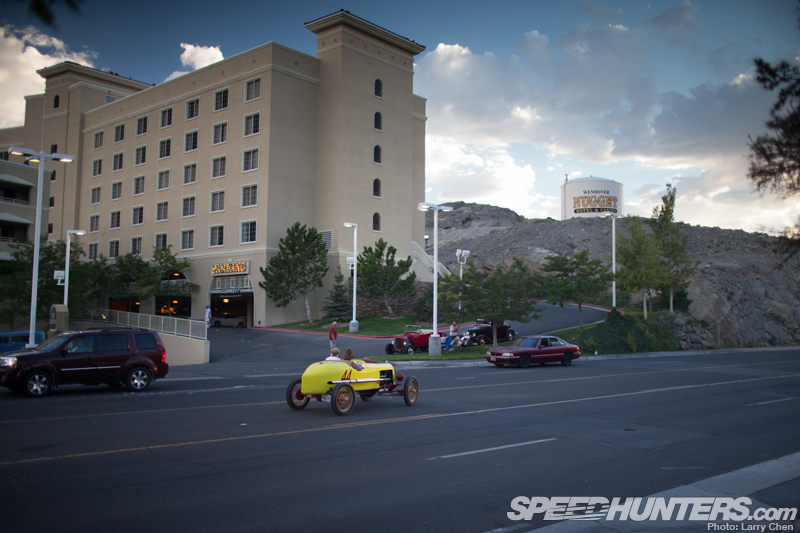
Speed Week doesn’t just bring out race teams though; a whole lot of hot rods, classics and jalopies also descend on the little town.
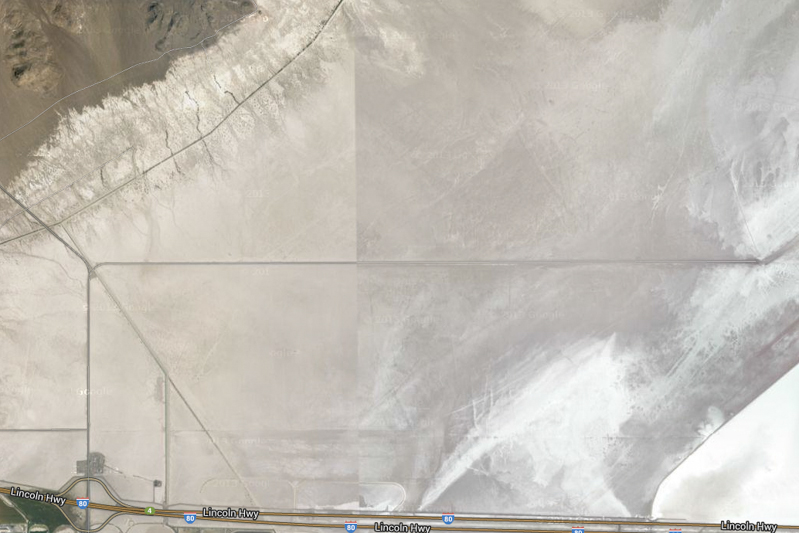
From Wendover, a quick trip on Interstate 80 brings us to the turn-off for Bonneville Speedway. After exiting you follow the paved road north, then around The Bend until the pavement turns to salt. Photo courtesy of Google Maps
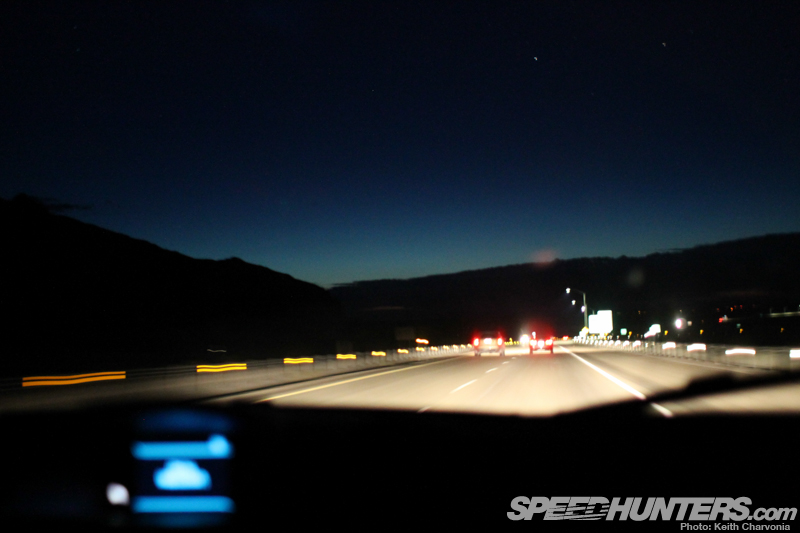
Of course Larry and I experienced this part of the trip in the dark as we raced the rising sun each morning.
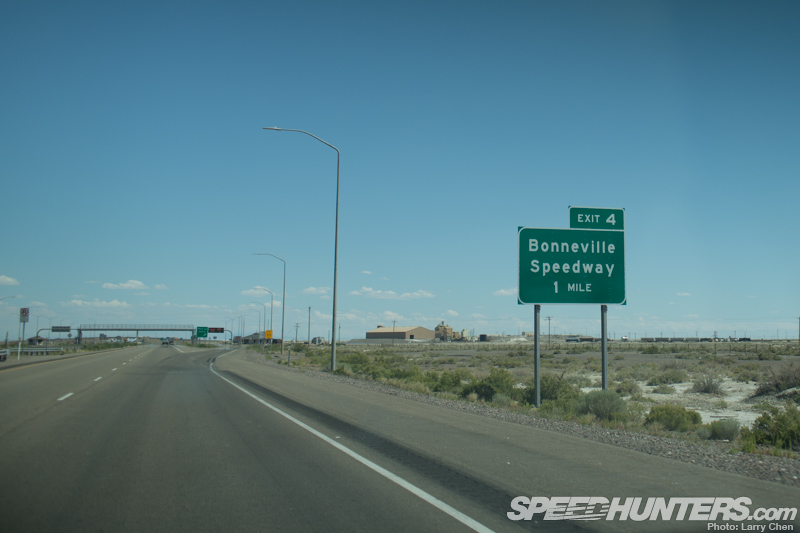
If you’re a normal person who sleeps this is probably what you would see.
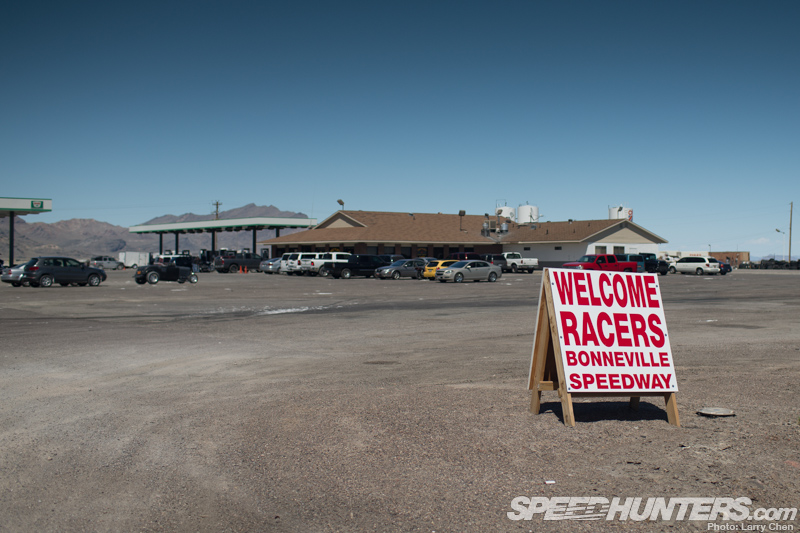
The only place to stop before you hit the salt is this old gas station…
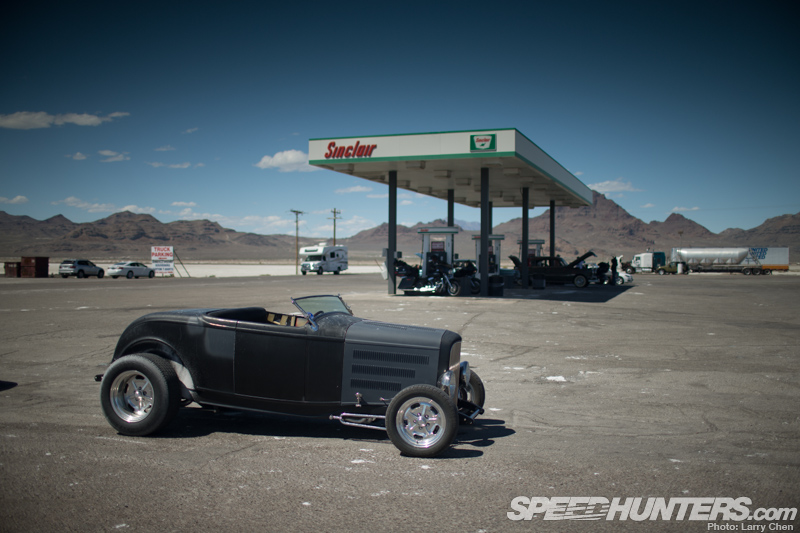
… which is a guaranteed place to spot hot rods.
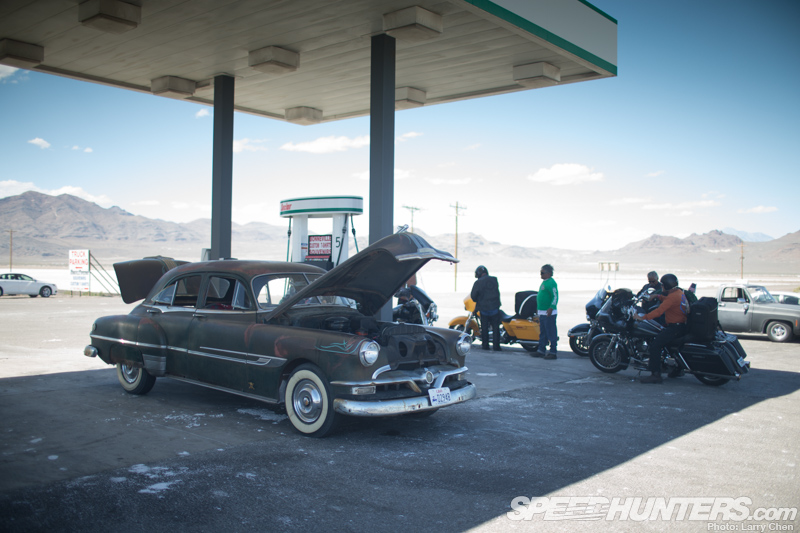
It’s also your last chance to fuel up and buy ice.
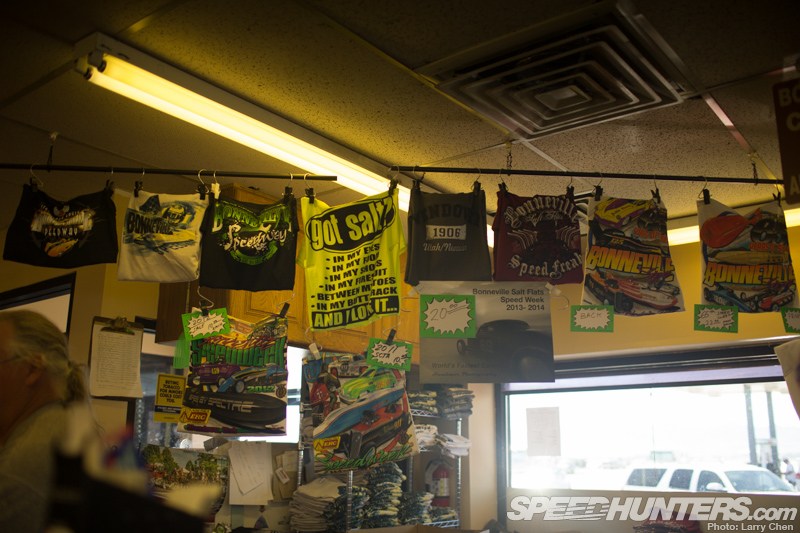
They have the best selection of event shirts, so this is where you want to buy one. If you wait until you get to the race course the choices are more limited.
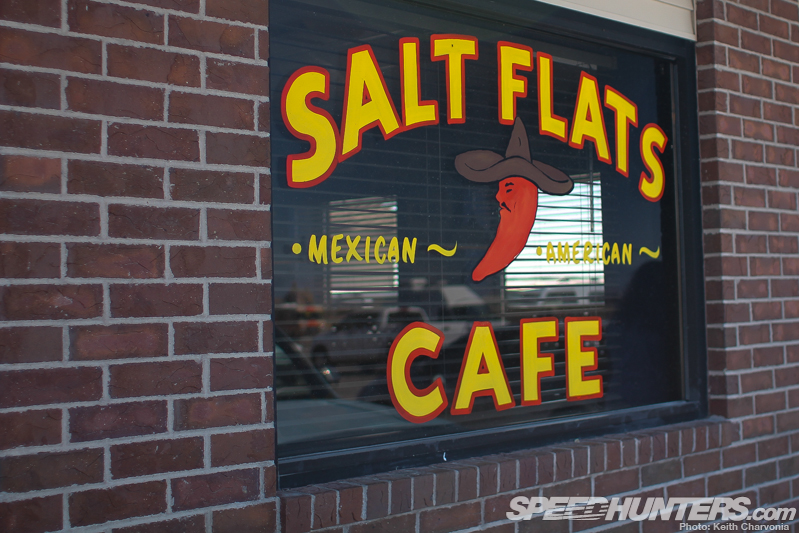
Attached to the gas station is a small cafe that’s always packed with spectators and race teams.
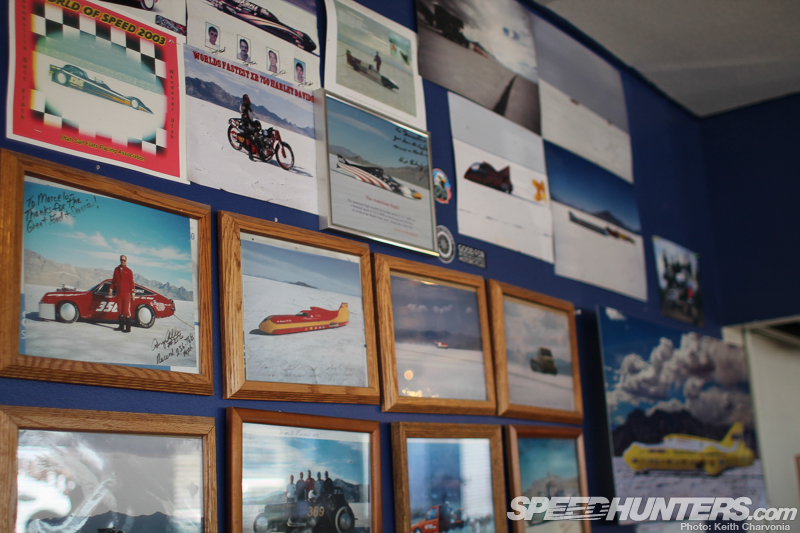
Over the years they’ve collected enough racing memorabilia to cover every wall.
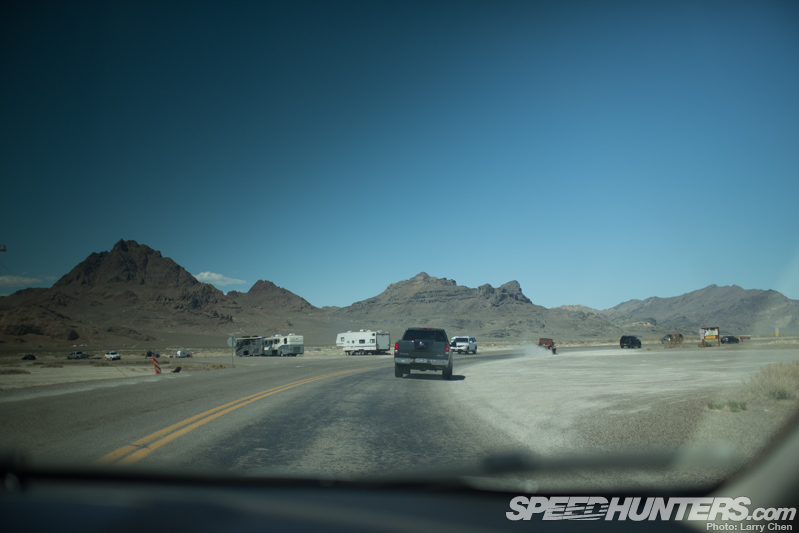
Back on the road we round The Bend and head due East.
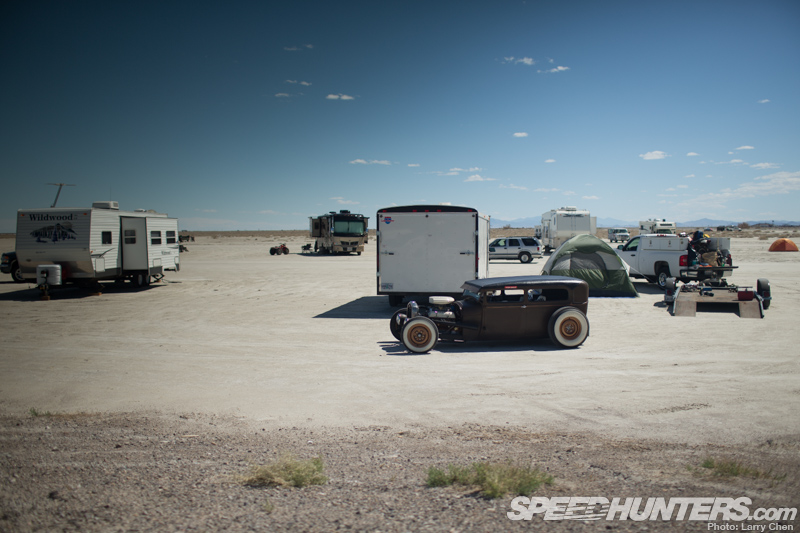
The Bend is where most people camp and park their RVs. It’s a fun place to be at night since most everyone is partying. Someone usually puts on an impromptu firework show too.
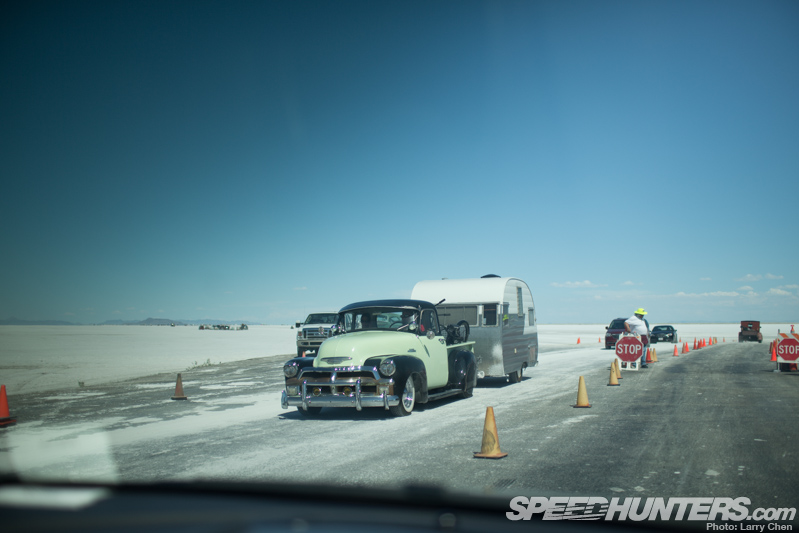
As we near the end of the paved road the SCTA is set up to collect your entry fee.
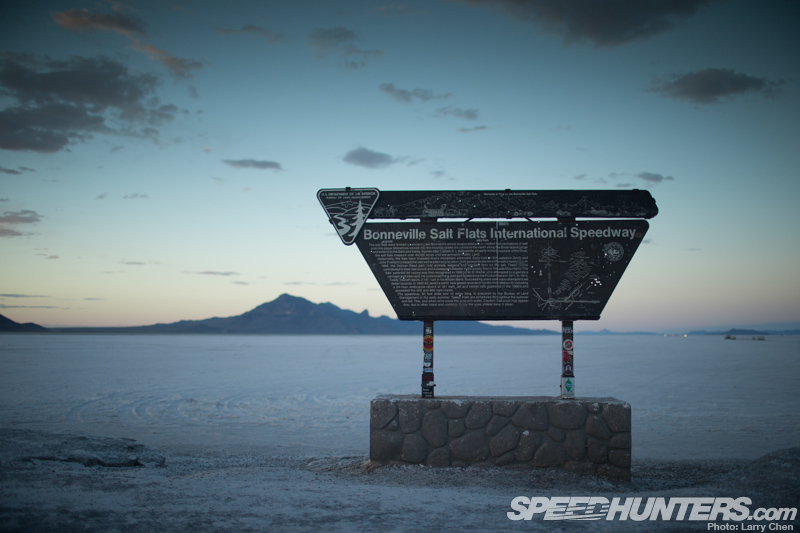
This is also the location of the famous Bonneville sign where everyone poses for pictures. Many donuts have been performed by hot rodders in the salt behind this sign too.
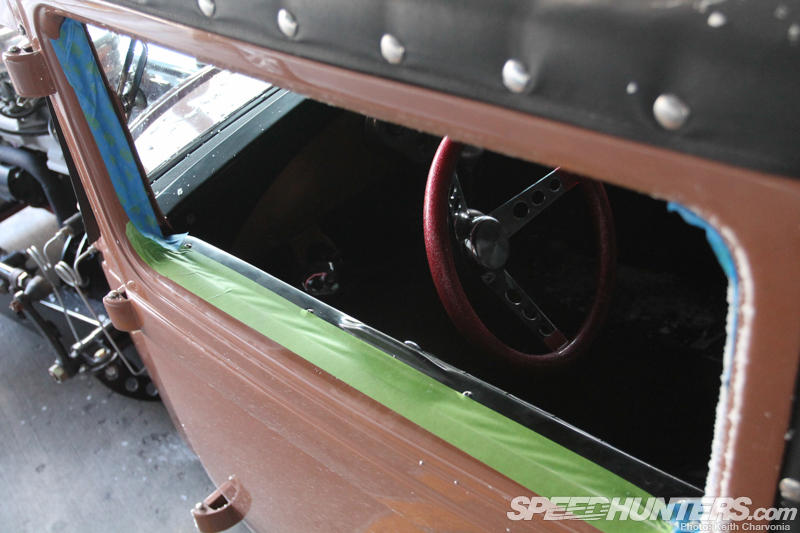
If you have a hot rod without side windows this would be a good place to stop and tape up all the gaps, so as to avoid filling the doors with salt.
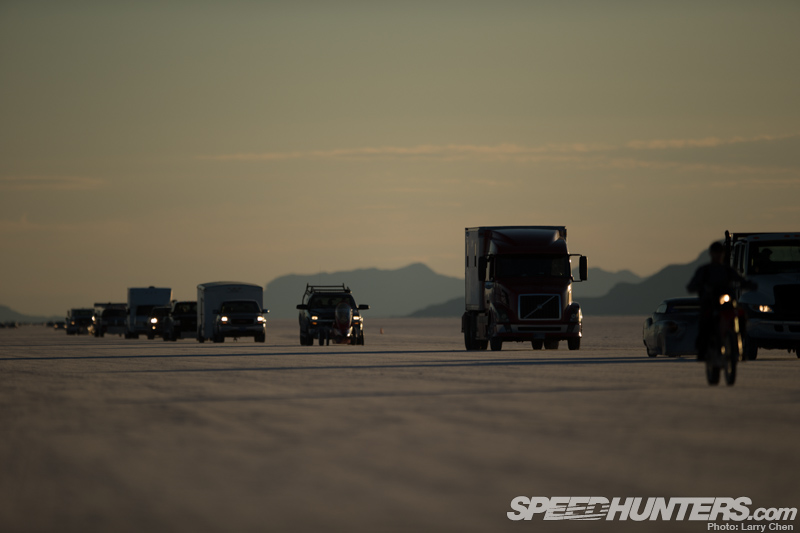
Racing starts at 7:00 am, so if you show up a little early you’ll usually end up in a giant convoy across the salt. The drive is several miles and the speed limit is 55 mph, so everyone pretty much just hauls ass!
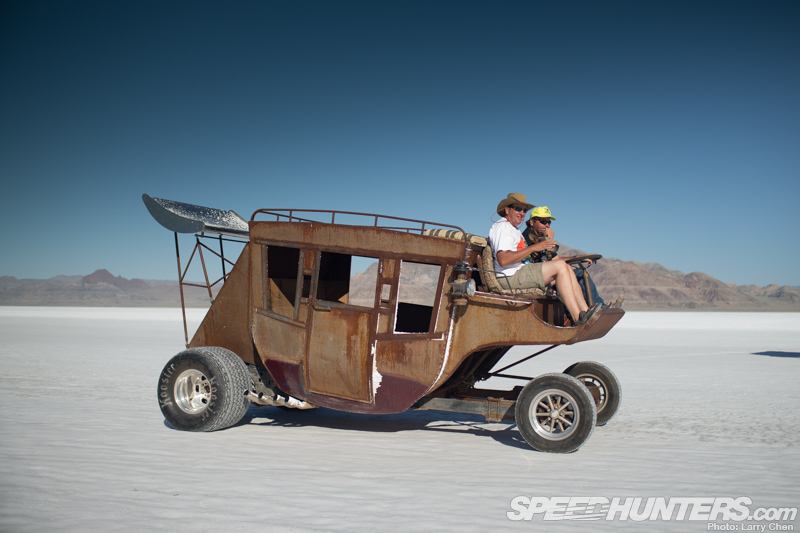
Of course Bonneville brings out some of the most unique vehicles in the world, so you might find yourself driving next to a V8 powered stagecoach.
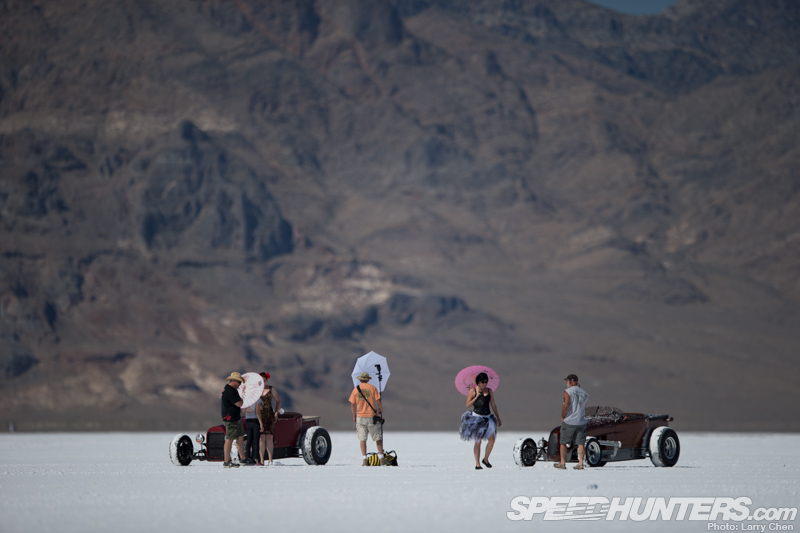
If you look off to your left there is usually a photoshoot going on. There’s an expanse of unused salt here that creates a huge natural photo studio. Be careful though – the further out you go, the softer and thinner the salt gets. It’s easy to get your car stuck out here.
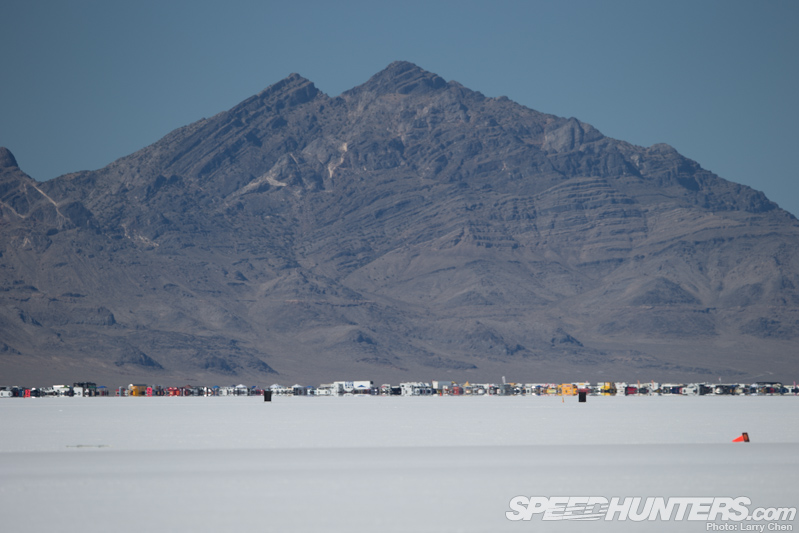
The first two miles of the course are lined with spectators, then the pits make up the next few miles after that. This line is 1/4 mile away from the nearest race course. Obviously you shouldn’t be much closer should something go haywire with a 400 mph streamliner. The sound from here is something you’ll only hear at Bonneville – the pulls are long and sustained, and you can hear the car coming before you see it. The pitch drops as they pass, and you get a good long look as the car nearly crosses the entire horizon.
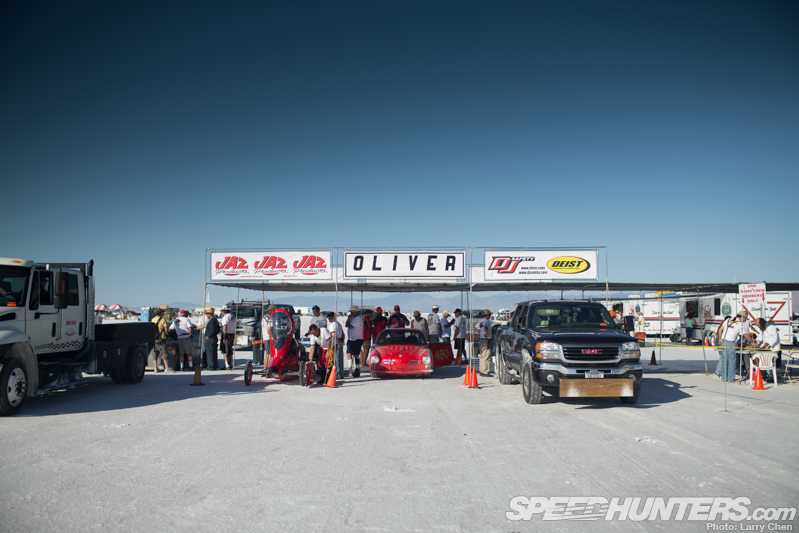
If you’re racing you’ll need to make a stop at Tech before you’re allowed to make a pass. This is where the car is checked over and the driver performs a timed bailout in front of the tech inspectors.
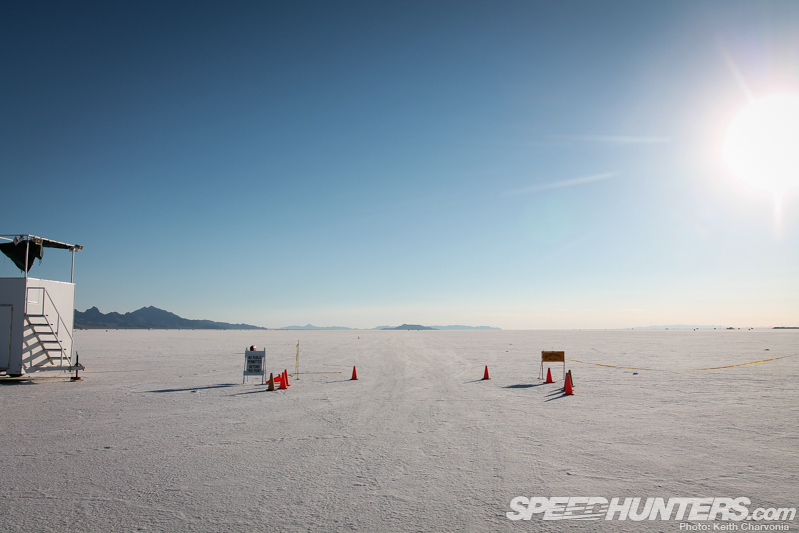
Between Courses 1 and 2 is Burford Blvd, which provides access to the race course for officials, crew and media. The small mountain in the middle of this photo appears to be a floating island and is what the racers are aiming for as they make their pass down the salt.
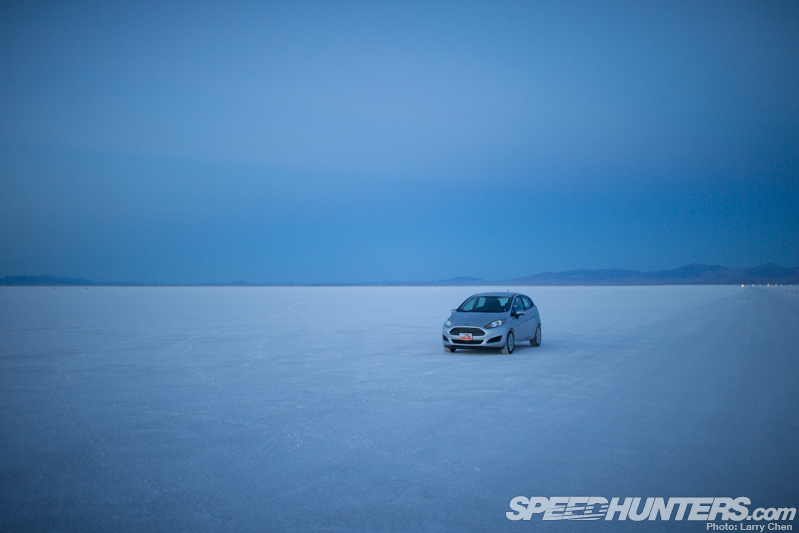
We drove our Aston Martin press car Ford Fiesta rental car out to see the timing tower early one morning. This shot should give you an idea of the scale of the place. Those lights on the right are back at the starting line, three and a half miles away.
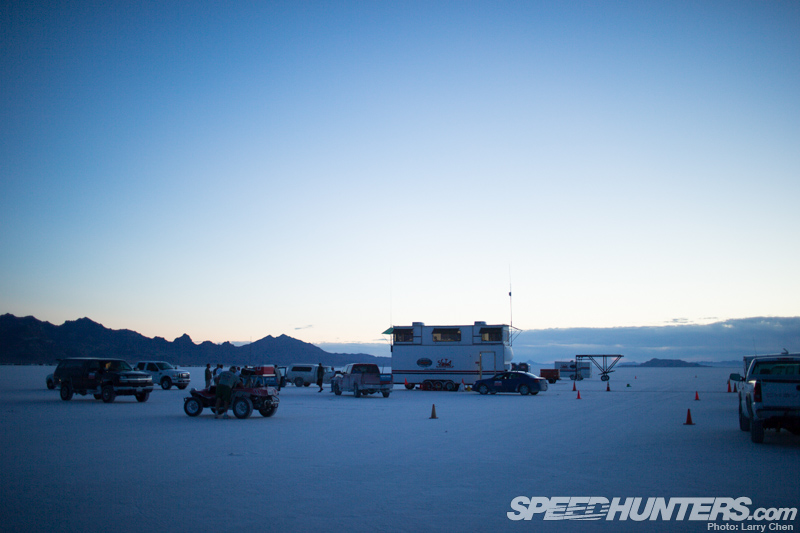
The Southern California Timing Association (SCTA) is the group that runs the races. We arrived as the officials were congregating to get their marching orders for the day.
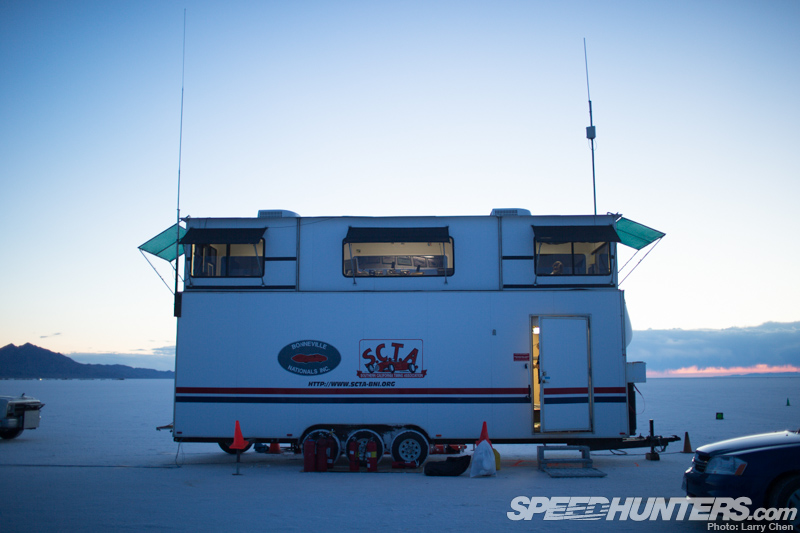
Everything is portable and leaves when the races are over, so the timing tower is really a large trailer filled with equipment.
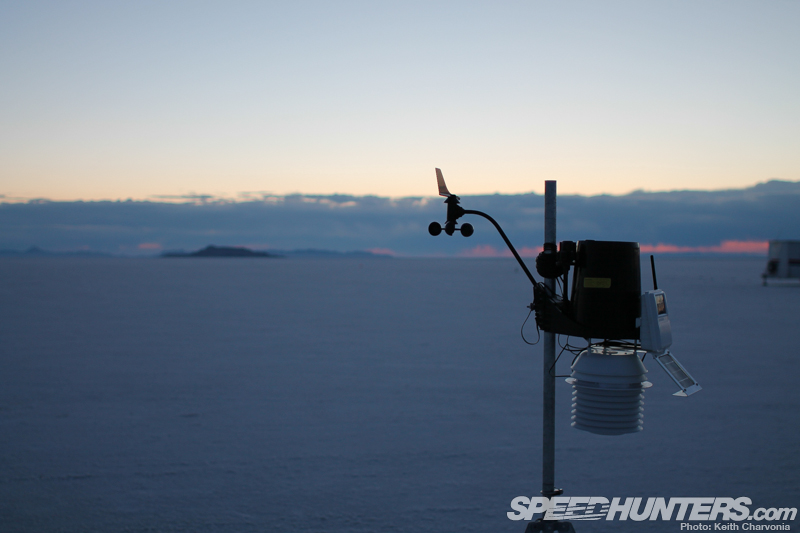
Outside there were a few small weather stations feeding information into the tower.
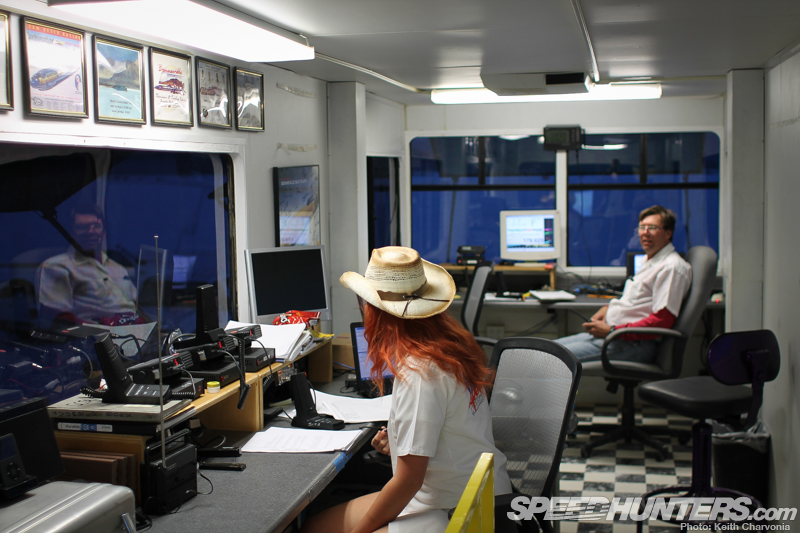
I was fortunate enough to get invited up into the tower to see their operation.
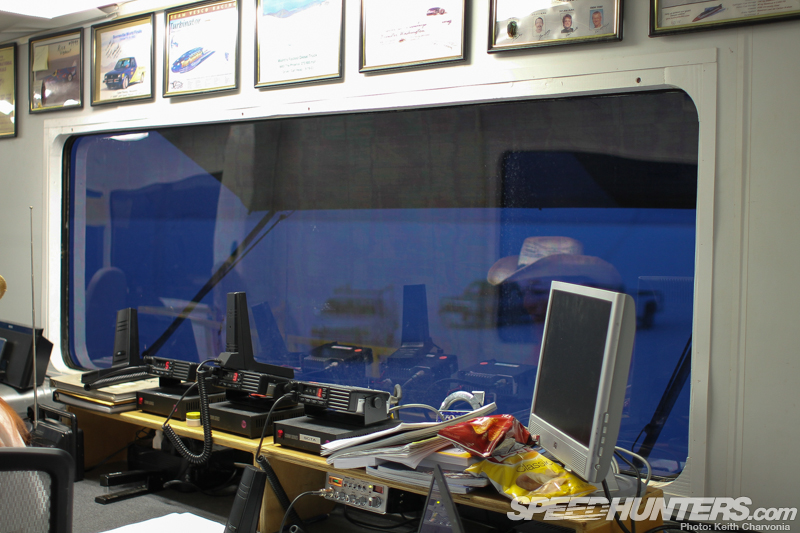
Lots of computers, radios and rulebooks covered the desks inside.
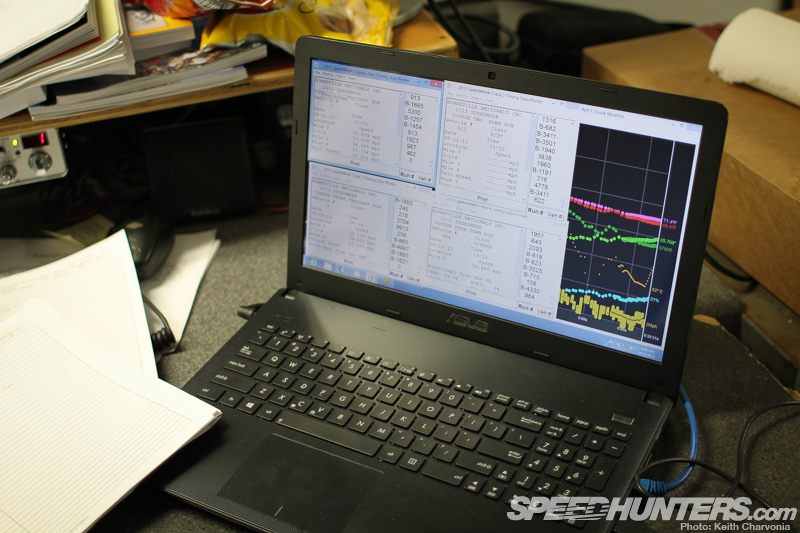
There was no shortage of data coming into the half dozen or so computers that were humming away.
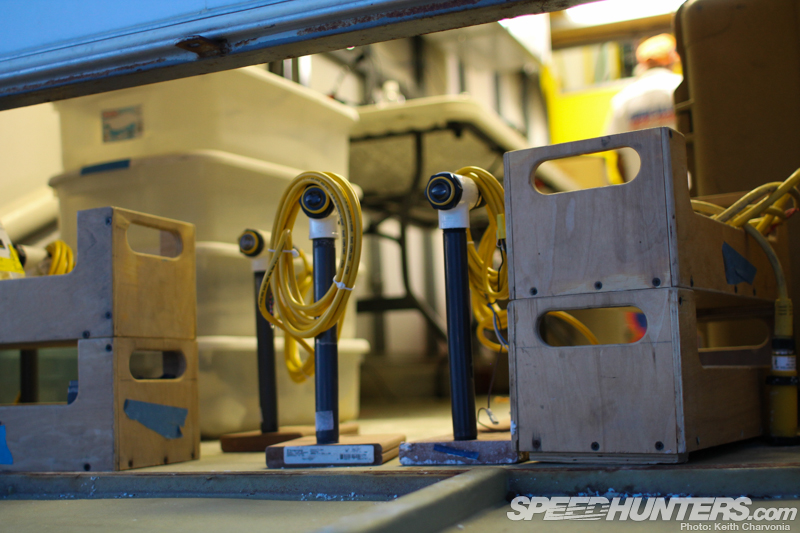
Back outside I spotted some spare timing lights ready for duty.
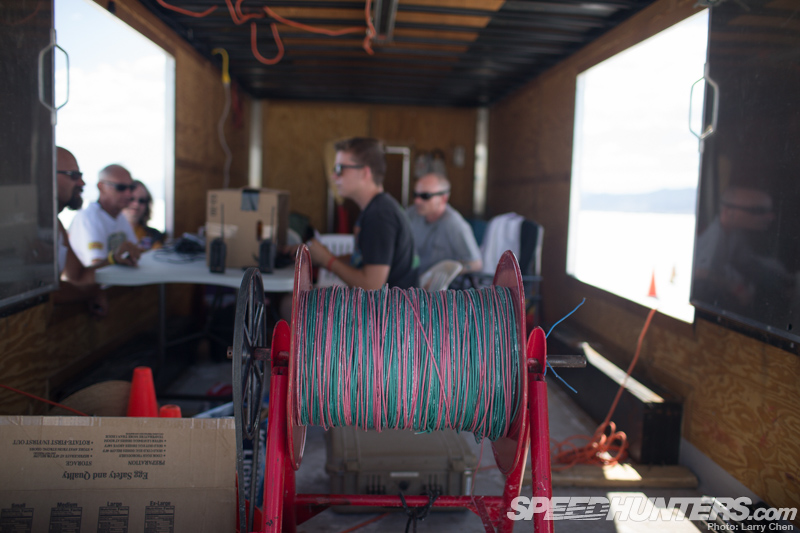
I also found the spools upon spools of wire interesting. This is surplus wire from WWII, which is carefully maintained by the SCTA and its volunteers. Each spool contains 10,000 feet of wire and weighs 220 lbs.
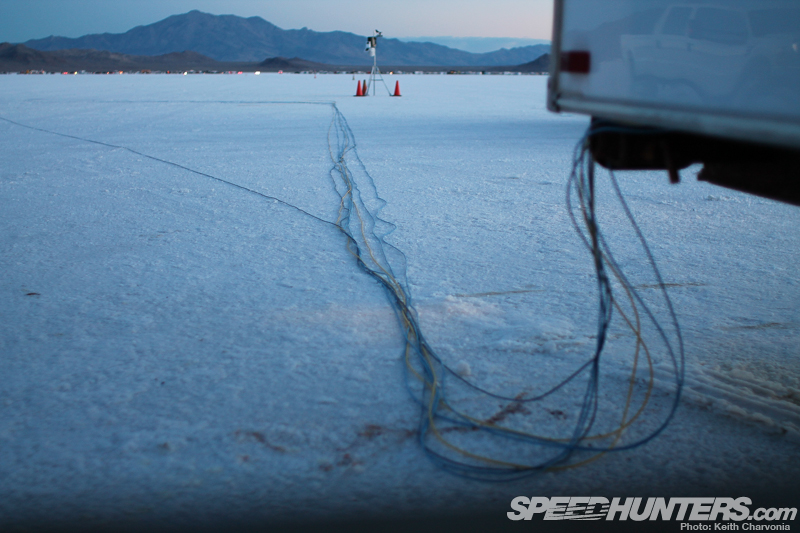
Every timing light on all four courses is hard-wired, so you can imagine how many miles of wire have to be strung out and connected for Speed Week.
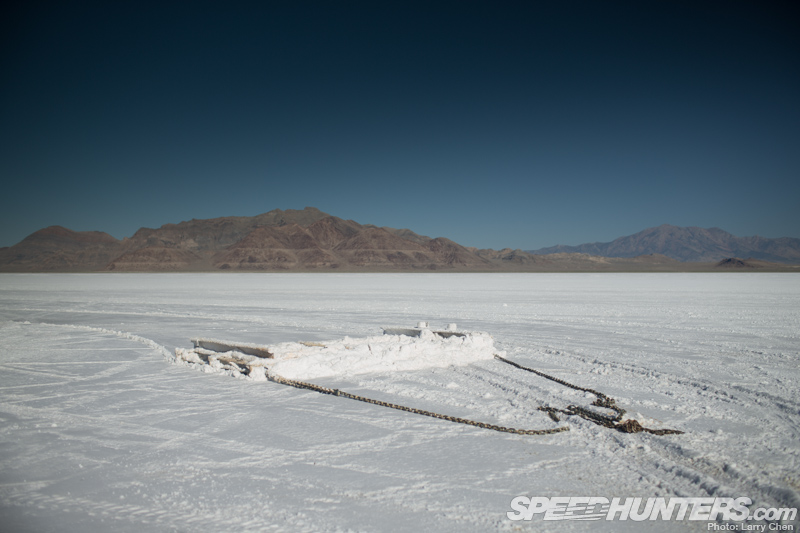
SCTA workers and volunteers show up the week prior to set all this stuff up. They also groom the salt by dragging these sleds for many miles.
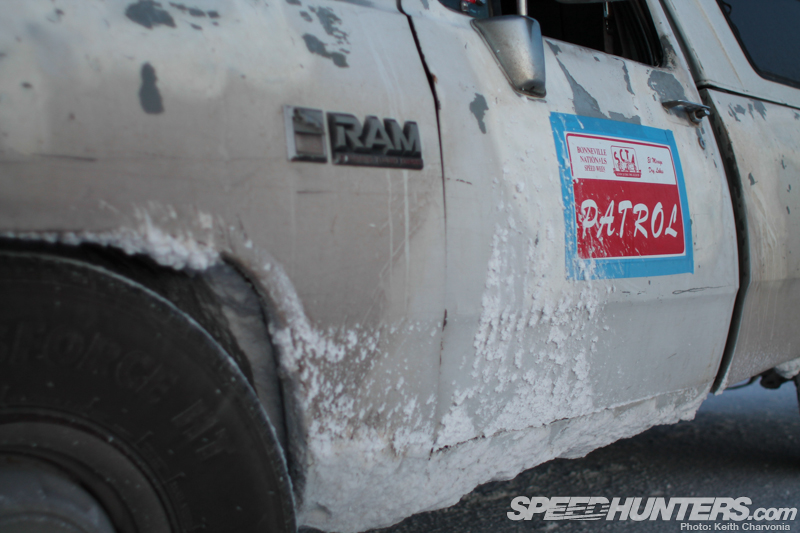
It looked like this truck had been working on the salt for decades.
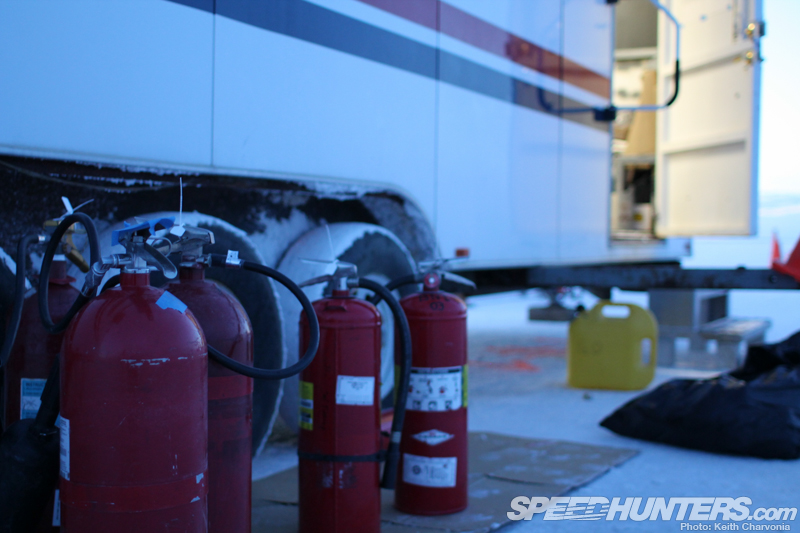
Safety is the SCTA’s top priority, and they take it very seriously. Landspeed racing began on the grassroots level here 65 years ago, and things have come a long way since those early days.

The early morning provides the best light at Bonneville, so Larry and I had to move quickly in those first few hours and saved breakfast for later. Fortunately there is a food stand serving hot food right off the grill all day.
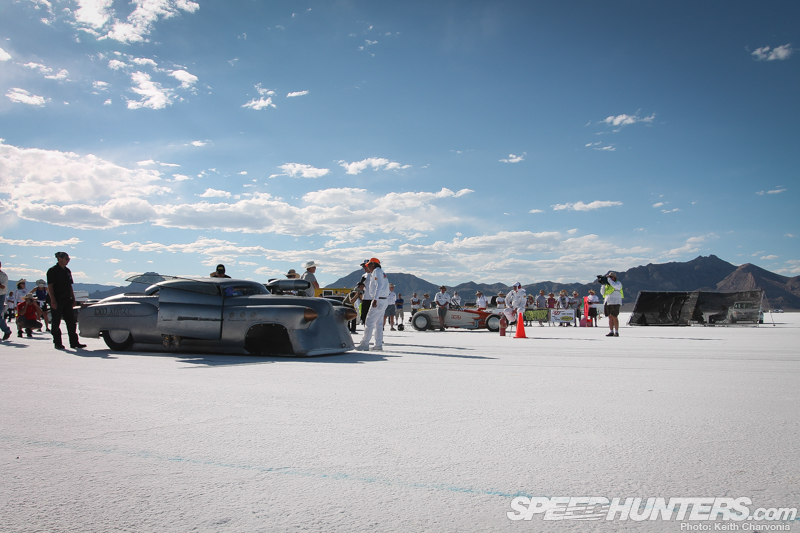
Racing goes on for about 12 hours a day, and the starting line is the only place to get close to the action.
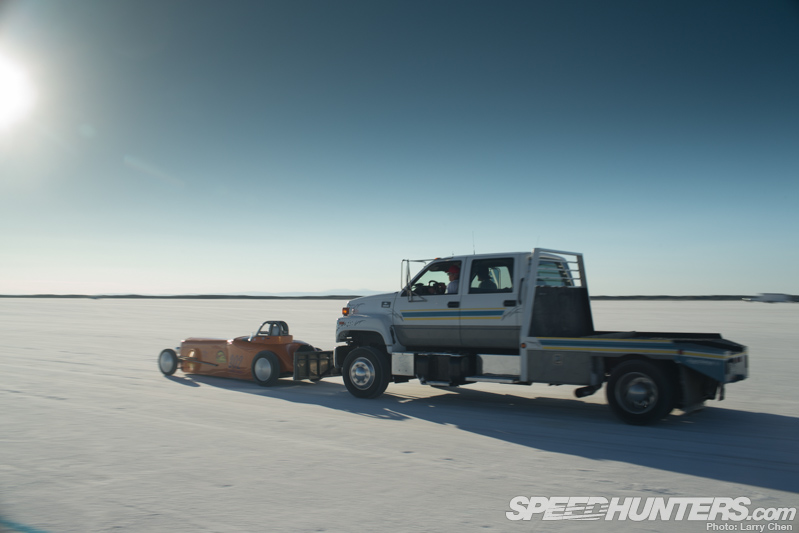
Compared to most motorsports the starts at Bonneville are pretty anticlimactic. The faster vehicles even need a push to get started, then you hear them dump the clutch and try to get the engine going from a very low RPM.
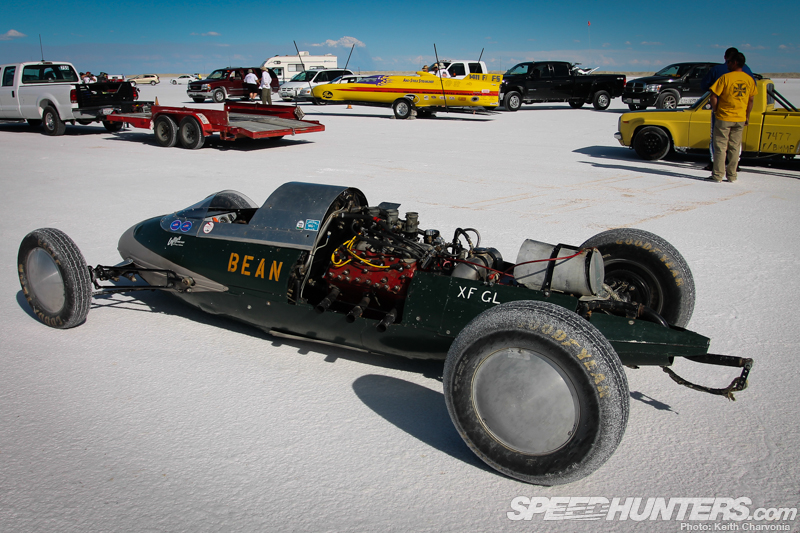
Streamliners like the yellow one in the background are the big dogs of the sport, but old belly tankers are just so much cooler to me.
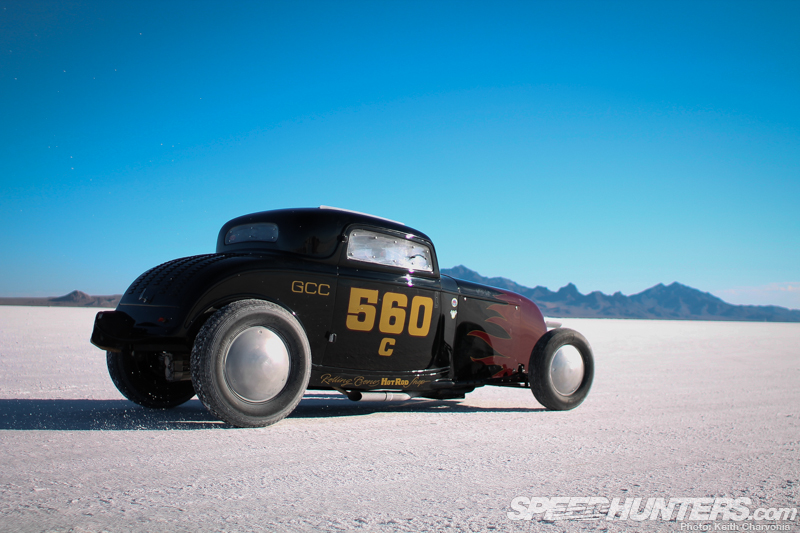
In the early years Competition Coupes weren’t accepted as real race cars; people thought only the topless roadsters could be fast. Coupes were eventually accepted, and in fact were some of the very first cars to get chopped tops in an effort to cheat the wind.
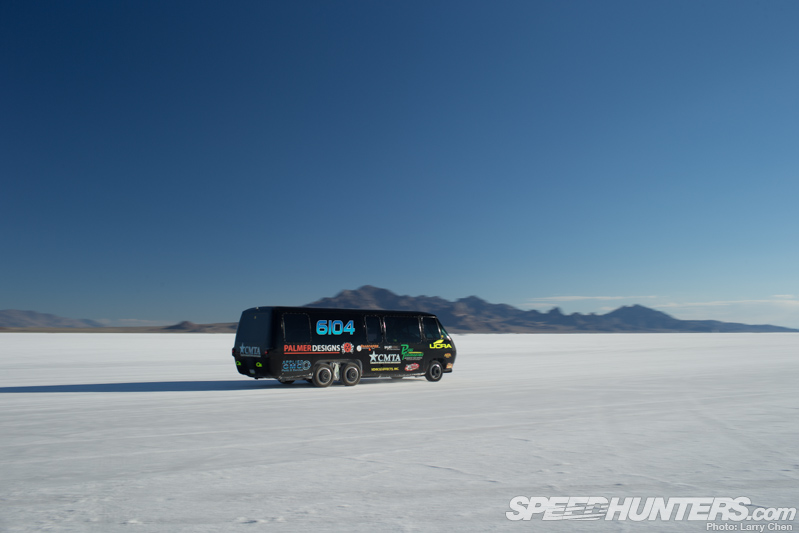
Today it seems like you can race anything you want and the SCTA will make a class for you.
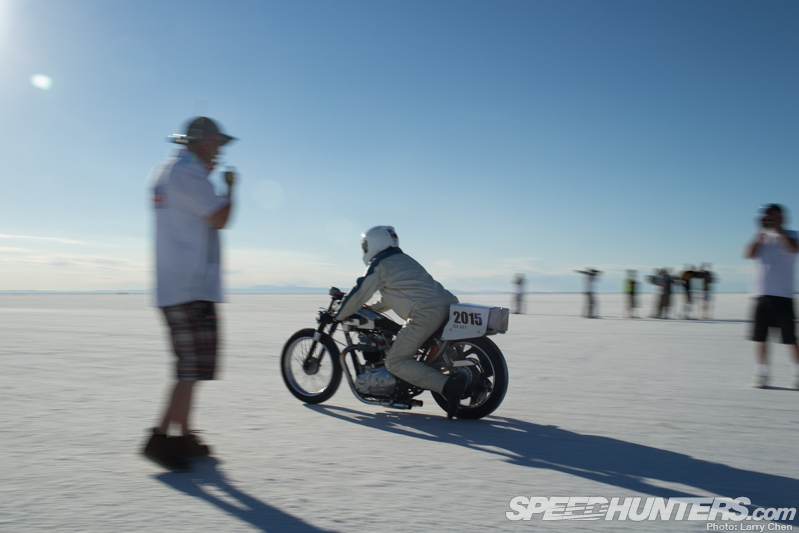
Motorcycles are very popular in landspeed racing too, and there are more classes than I care to count. I think I’d rather have a rollcage around me for this sort of venture though.
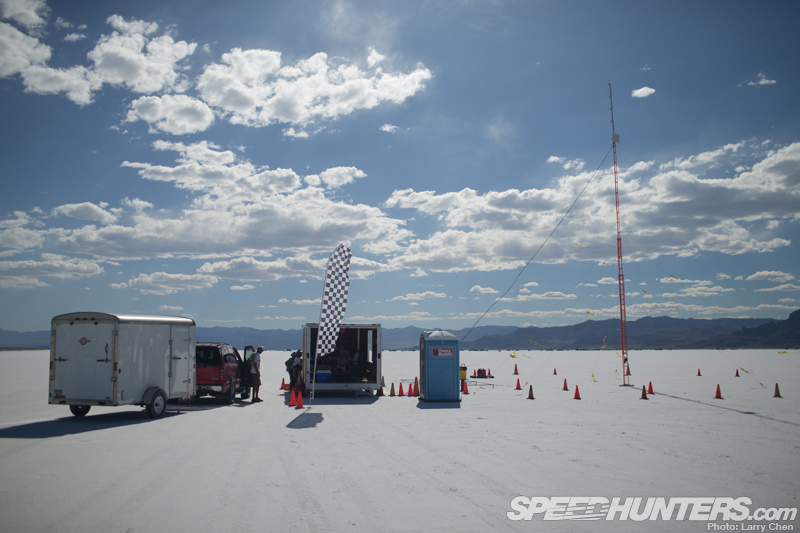
There were four courses this year: two short ones measuring three and four miles, and two long ones measuring seven and eight miles. The number and exact locations of the courses can change each year with the condition of the salt. The courses are marked by flags and big mile marker signs – a far cry from the black line of diesel fuel they used to dump on the salt for racers to follow.
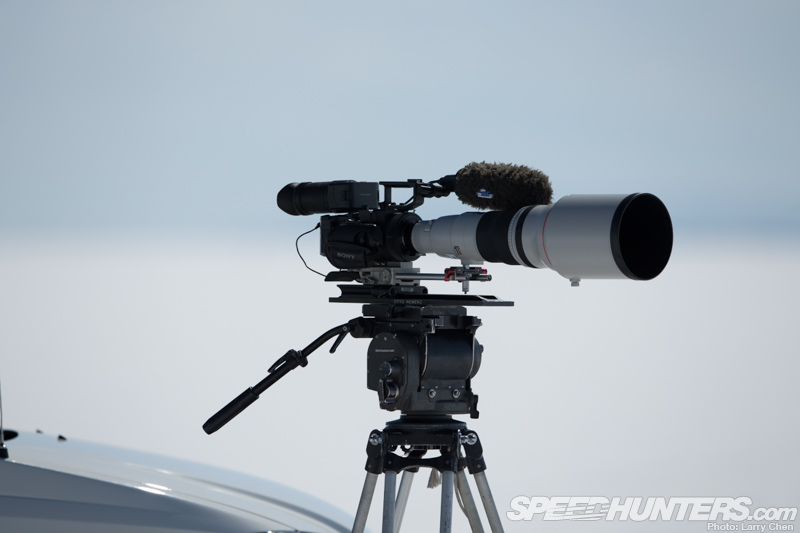
As you get out towards the finish line there are fewer people and more giant lenses.
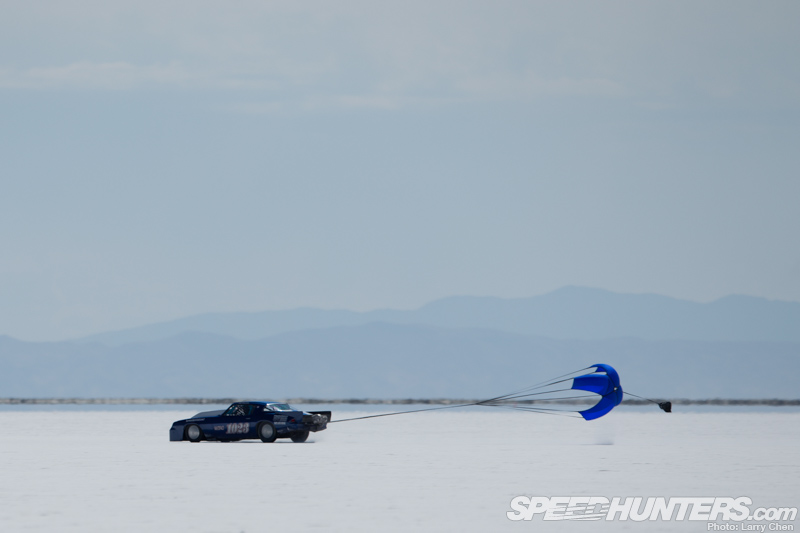
It’s a great place to see the cars at speed and witness the parachutes popping out. Notice the shockwave hitting the salt below the parachute in this picture!
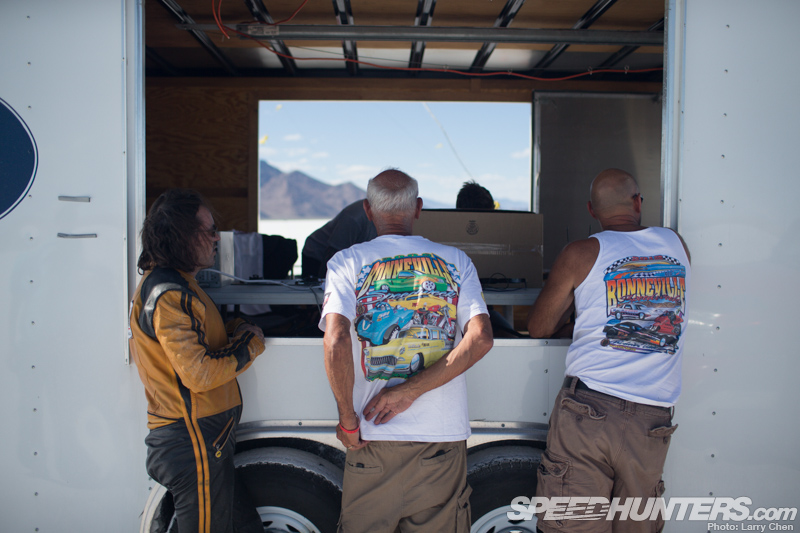
There’s a trailer on the return road where you pick up your timeslip.
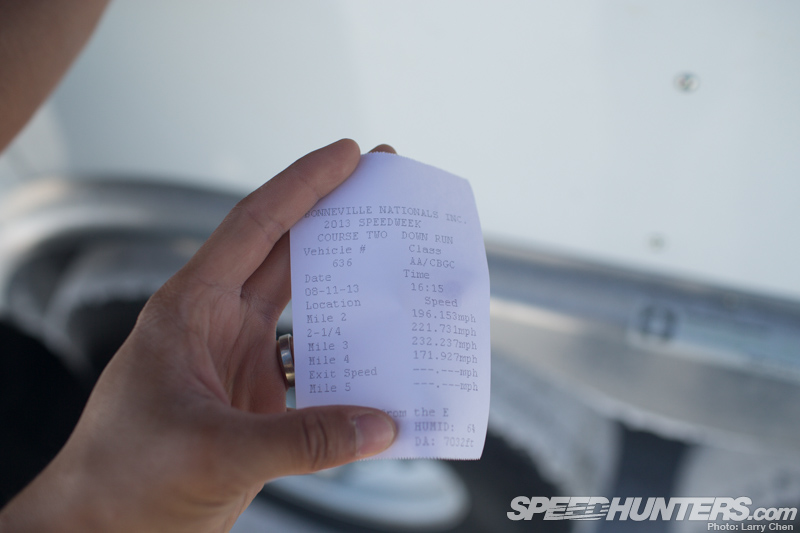
It’s printed like a receipt from the grocery store, but this can be a very special little piece of paper if things went well.
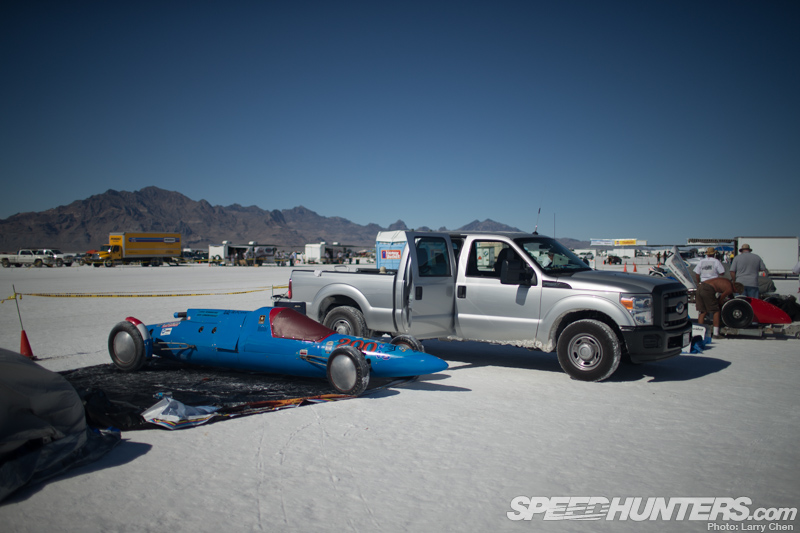
If you set a record in your class you are directed to impound. Within this roped off area you’re allowed up to four hours to work on your car, then it has to stay the night here untouched.
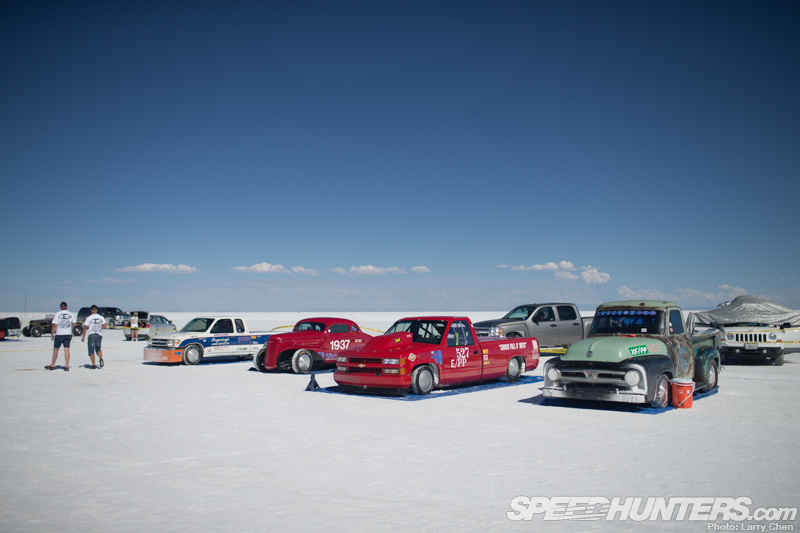
Record runs get priority and are the first runs in the morning. In order to officially snatch a record you have to back up your qualifying run a second time.
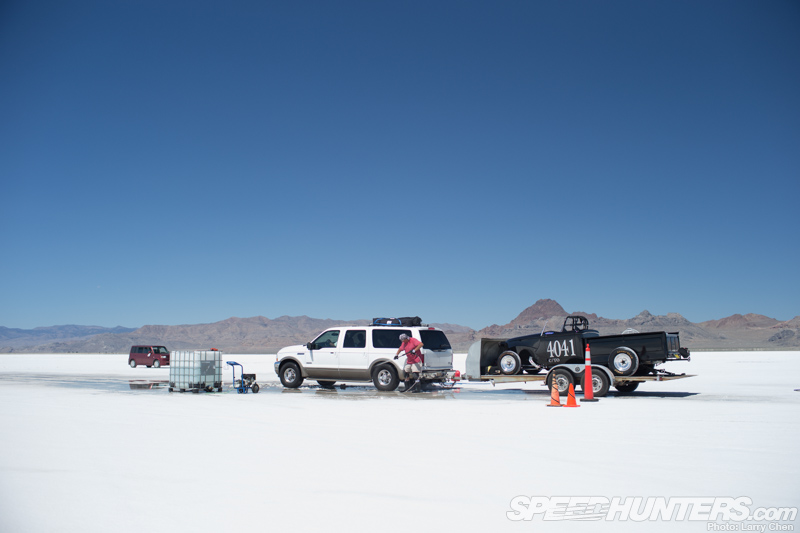
When you’re done racing or spectating you can wash the salt off your car on the way out.

Trust us, it gets everywhere.
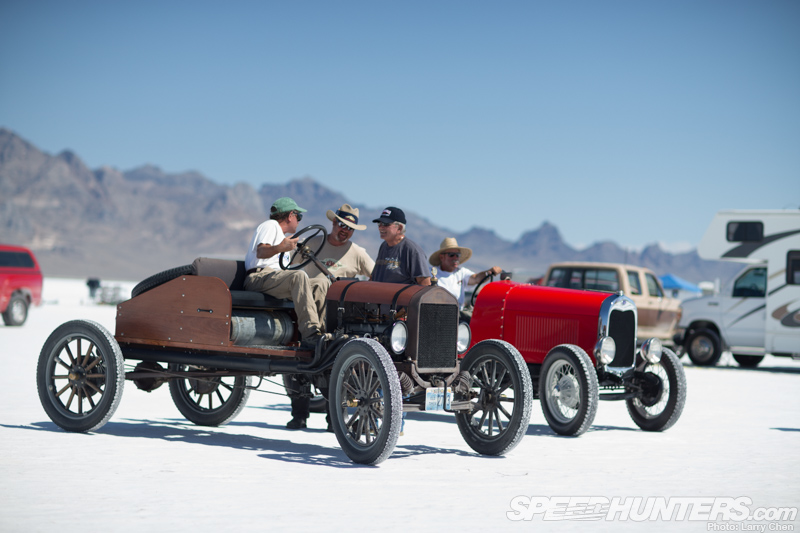
Or you can just hop in your old jalopy and head back into Wendover…
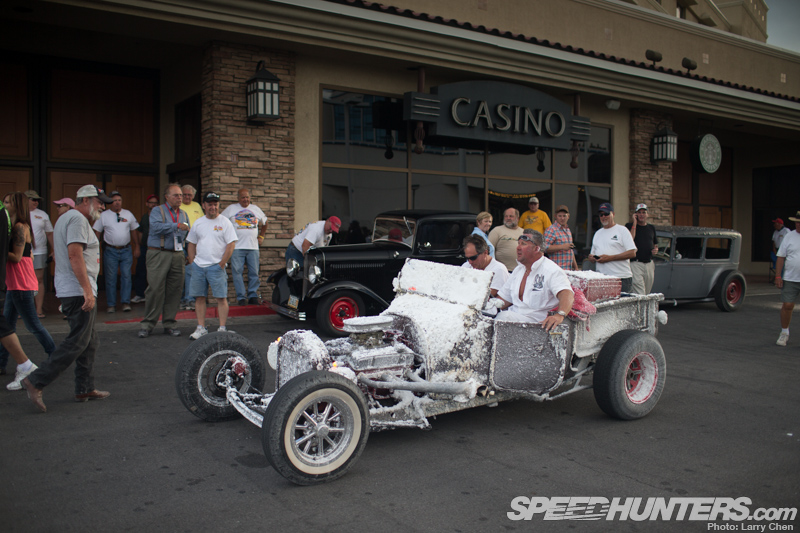
…where there’s an informal car show and hangout at The Nugget casino every night.
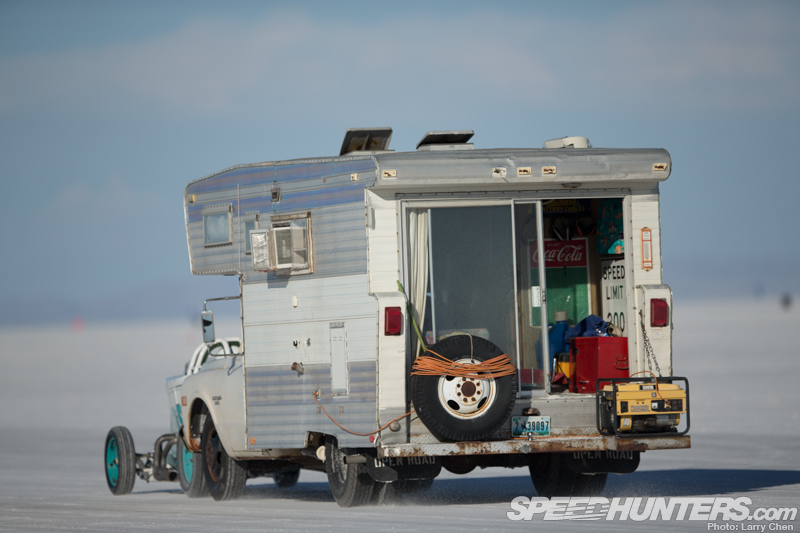
Don’t party too late though – you might miss the racing the next morning!
Words and additional photos by Keith Charvonia
Instagram: SpeedhuntersKeith
keith@speedhunters.com
Photos by Larry Chen
Instagram: larry_chen_foto
larry@speedhunters.com
BONNEVILLE: CHASING THE 300 MPH CLUB
More Bonneville stories on Speedhunters






Awesome pictures and website. My son and I are planning to go watch in 2014. We are making plans to ride the Harleys to Bonneville, aprox 750 miles. He will be a senior in high school and wanted to go on one last epic adventure before high school graduation. Super pumped to have the opportunity to experience this with my son.
They have been mining the Bonneville Salt Flats since before World War 1. The mining is insidious because the salt is taken away as a dissolved brine and pumped into many miles of ponds on the south side of the highway and railroad where solar evaporation helps to concentrate and dry the salt. You can see the collection canal at about mile marker 14 on I-80. Salt is sold for road salt, for recycling aluminum and other commerce uses after the potash for fertilizer is removed. What is returned to the racing surface is not the same as what is removed and the crystalline bonding does not set up a hard. Ab Jenkins used dynamite to dig holes for the latrines in the 1930's because it was almost impossible to get through the salt any other way. He set up facilities that were rented to other racers and his son Marv used the rent fees to pay for college. Mining is conducted under leases issued by the BLM and they collet the lease payments but do very little to maintain anything on the salt surface.
Sooooo, I guess I can race my 2013 BMW HP4 motorcycle at Bonneville after all,, to see what I can do..
G.G. Dupuy
Ontario, Canada
Apart from a lack of info on how the salt flats themselves were formed, I found this piece to be quite interesting. The flats, by the way, are the result of climate change around 15,000 years ago.
Oh, and in Season 12 Episode 2 of Top Gear UK, the presenters took part in these races, Jeremy setting a new record for production cars in the process.
http://www.streetfire.net/video/top-gear-season-12-episode-2_part-1_2380657.htm
Its incredible how fast these cars can go on the salt flats. Those pictures look amazing